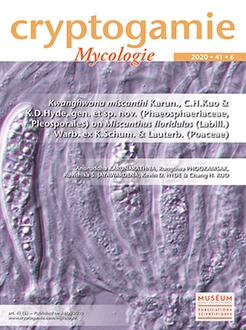Anuruddha Karunarathna, Rungtiwa Phookamsak, Ruvishika S. Jayawardena, Kevin D. Hyde, Chang H. Kuo
Cryptogamie, Mycologie 41 (6), 119-132, (4 May 2020) https://doi.org/10.5252/cryptogamiemycologie2020v41a6
KEYWORDS: Dothideomycetes, graminicolous fungi, Taiwan, new species
We are studying microfungi growing on Poaceae hosts in different geographical regions and in this study we introduce Kwanghwana miscanthi Karun., C.H.Kuo & K.D.Hyde, gen. et sp. nov., based on phylogenetic analyses of DNA sequences of four loci used in combination (three ribosomal (LSU, SSU and ITS) and one protein coding region (TEF1-α)) and on morphological characters. This new genus, including a single species isolated from Miscanthus floridulus (Labill.) Warb. ex K.Schum. & Lauterb., is molecularly distinct from closely related genera, Neostagonosporella C.L.Yang, X.L.Xu & K.D.Hyde, Setophoma Gruyter, Aveskamp & Verkley and Edenia M.C.González, A.L.Anaya, Glenn, Saucedo & Hanlin. Kwanghwana miscanthi Karun., C.H.Kuo & K.D.Hyde, sp. nov., also differs from Neostagonosporella and Setophoma by having subglobose ascomata, irregularly thickened peridium, cellular, septate and branched pseudoparaphyses, and fusiform, broadly fusoid, 3-septate ascospores.

